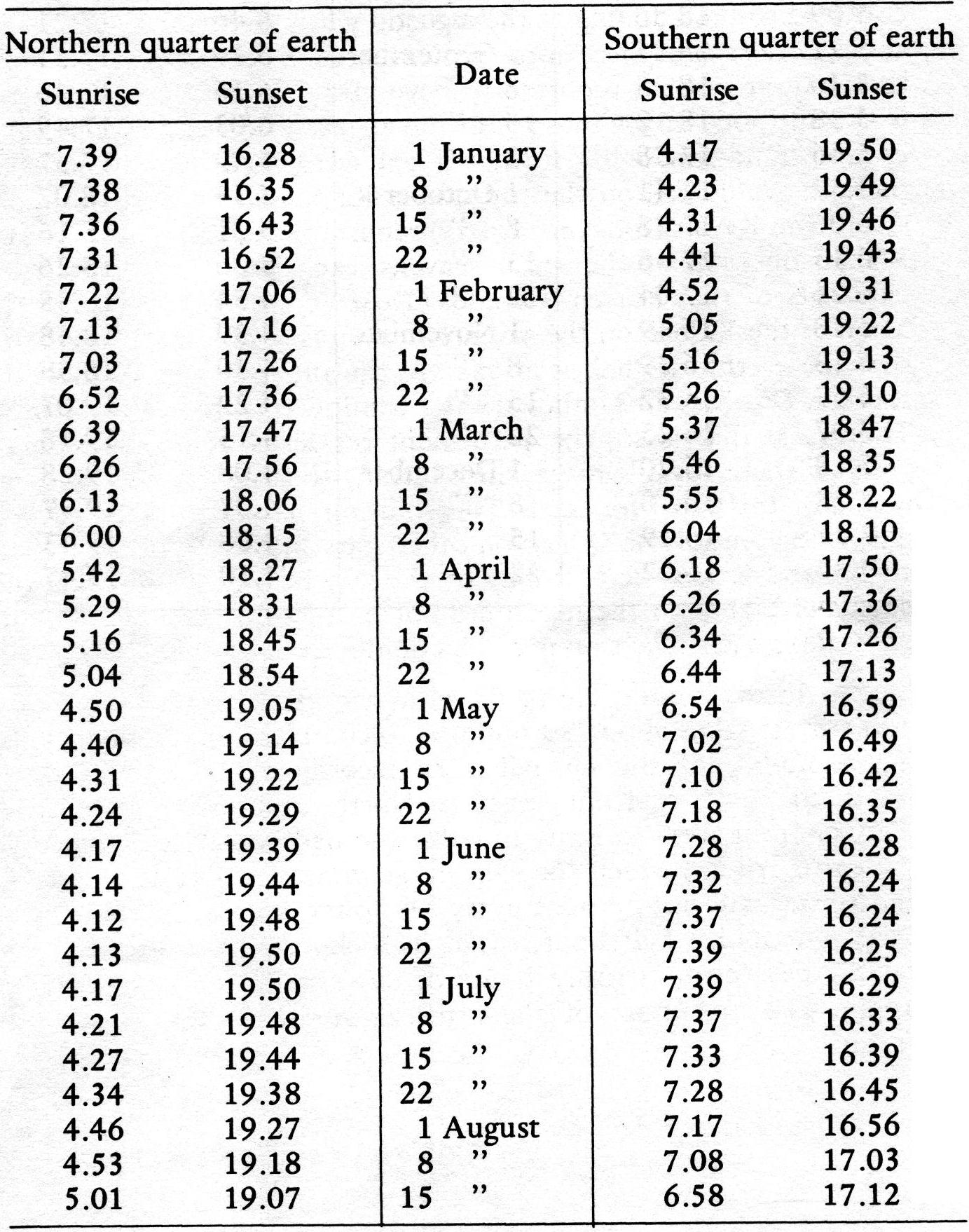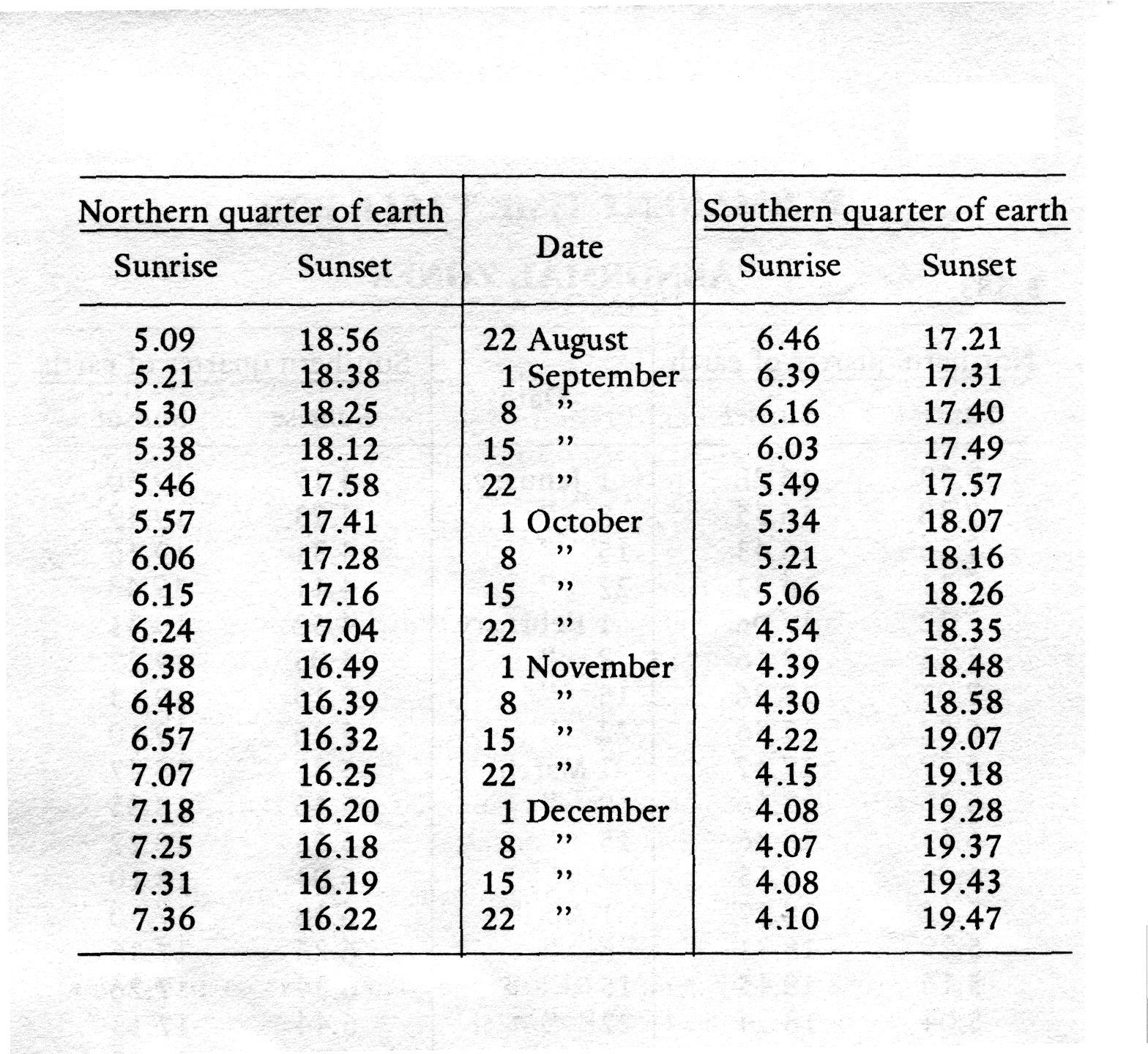|
Islamic Daily Prayers in
Abnormal Time Zones
by Dr. Muhammad Hamidullah
From
Ch. 15 Introduction to Islam
581. As has been explained
in the chapter "Daily Life", normally a Muslim has to celebrate five services
of worship of God every day:
1. Dawn service, any
time between the appearance of the true dawn, about 1½ hours before
sunrise, and the sunrise.
2. Midday service
(zuhr) from noon to late afternoon ('asr). Noon means half
the time between sunrise and sunset. For instance, if the sun rises on
22nd December at 7.36, and sets at 16.22 the day is of 8 hours and 46 minutes.
Half of this is 4.23. Add this to the time of sunrise (7.36 + 4.23 = 11.59).
After the precautionary quarter of an hour, one may pray for midday service
at 12 hours 14 minutes, till the time of 'asr prayer.
3. For late-afternoon
service ('asr), the time begins at half of the time of afternoon,
i.e., from noon till sunset. So if the noon is at 11.59, and sunset at
16.22, the afternoon has 4 hours 23 minutes. Add half of it, 2.12, to the
time of noon (11.59 + 2.12= 14.11). After the precautionary quarter hour,
one may pray 'asr on that day at 14.26. Of course in summer the
time will be much later.
4. Evening service,
from sunset till the disappearance of the twilight, about 1½ hours
afterwards.
5. Night service,
from the disappearance of the twilight till the appearance of the dawn,
i.e., the time of the first service. Yet in regions far away from the equator,
these times are too inconvenient to be practical. So instead of the movements
of the sun, one calculates and follows the movements of the clock: and,
as has been explained, the times obtained at the 45º North or South
Latitude are valid in all the regions between 45º N or S and the pole.
So, Bordeaux-Bucharest in Europe, Portland-Halifax in North America constitute
the limit of the normal zone; all countries North of these places have
to follow the time table of these places. Mutatis mutandis the same applies
to countries in the extreme south of Argentina and Chile in South America.
582. Below are given the
hours for both 45º North Latitude and 45º South Latitude, in
local time. A few words of explanation will be useful:
(a) We have given only the
times of sunrise and sunset. Hours of services could be calculated according
to the formula given above.
(b) There is a vast difference
between the local time and civil time, and in fact on the equator every
15 miles or so produce the difference of a minute; the nearer we are to
the pole the shorter is the distance for the same quantity of the difference
of time. In large countries like the USA, Canada or Russia, the sunrise
on their eastern frontier is 5 to 10 hours earlier than on the western
frontier. Our timetable is based on the local time, and necessary adjustments
with the "civil time" in use in a country may not be difficult for the
intelligent inquirer. For instance, clocks in France are in advance of
an hour over the real local time in winter, and of two hours in summer:
When the clock strikes 12, it is really 11 o'clock in the local time in
winter, and 10 o'clock in summer. One has to take into consideration this
fact for the daily services of worship as well as for the beginning and
breaking of the fast.
(c) On account of the sphericity
of the earth, an arbitrary line had to be drawn where the day should begin.
The date line now in use passes between Asia and America - and political
considerations have deviated it at different points. It has its importance
for Muslim passengers proceeding, say, from Japan and Australia-Indonesia
to America and vice versa, by ship or by plane. When travelling to America,
as soon as they cross this imaginary line, there is a difference produced
of 24 hours: Saturday becomes Friday, and another Saturday comes in due
course. And when arriving from America to Asia, a whole day has to be added
at the same point and a Friday becomes instantaneously a Saturday. If one
lands before noon, Friday service has to be observed according to the day
of the destination and not the day of the country which the traveller had
left.
(d) The faster air travel
becomes, there will be newer problems to be decided. It is now possible
to start, say, soon after sunrise and after some time, in a westerly direction,
arrive in a country where the sun has not yet risen, observing en route
the setting of the sun in the east; or when the departure takes place after
sunset, the rising of the sun from the west! (who knows if that is not
the sense of the prediction of the Holy Prophet of such a phenomenon as
a sign of the end of the "old" world?) Inversely a country may be left
at six o'clock, and after three hours only the local time would be 12 o'clock
instead of 9.
(e) Among many problems that
arise by rapid air travel, is the question of the time of breaking the
fast. If someone has taken his sahur (meal prior to fasting) at
4 A.M. in the springtime and starts, say, at sunrise (6 A.M.) from Tokyo
to Tunis, via Tashkent. After 8 hours' flight at 900 km an hour when the
plane lands, the local time will not be 2 P.M. but still 6 A.M. in the
morning, and the sun will have just risen! This is so because there is
a difference of some 8 hours in the times of the sunrise in both these
places, and the plane has flown westwards in the direction of the "march
of the sun" with the same speed as the sun itself. Now, if the passenger
waits till 6 P.M., i.e., sunset in Tunis, he will have to fast not for
14 hours, but 22 hours. Similarly if he travels from Tunis to Tokyo, the
time will run twice as fast as the normal time, and after 6 hours' flight
when his wristwatch would show 12 o'clock midday, the sun will be setting
somewhere east of Tashkent and after two more hours when he lands in Tokyo
at 2 P.M. of Tunis time, it will be 10 o'clock in the night in Japan. Similar
phenomena are encountered if one flies from the North to the South or vice
versa, when apart from the time difference, there is even a change of season.
December is the time for winter in Norway and Canada, while it is summer
at the same time in Chile and Cape Town. Common sense demands that on the
day of such travel by air, one should abide by the time of the starting
place and not by the ever-changing local time of the countries traversed,
and this is for the fast as well as for service of worship.
(f) If and when a Muslim
lands on the moon, it will obviously not be possible to face the earthly
Ka'bah in the service of prayer; nor to follow the sun's rising, passing
the meridian and setting on Earth. What I humbly submit to the Muslim jurists
is to construct a Ka'bah on the moon, at the point which would be face
to face with the earthly Ka'bah, during equinox time, during a full moon
night when our satellite is just above Mecca. That is, a bit North of the
centre of the face of the moon that we see. I think that would lie in the
region named "Ocean of Tranquillity". I am personally so much the more
convinced of this solution, since the Ka'bah is not confined to the building
of the ten odd yards high, but also what is above in the atmosphere up
to the heaven. In a Hadith of al-Bukhari, the Holy Prophet is reported
to have said that the Earthly Ka'bah is the antipode of the mosque of the
angels underneath the Throne of God, (and so exactly so that if one were
to throw a stone from there, it would fall on the top of the Ka'bah on
earth). The great savant Ibn Kathir (Bidayah, 1, 163) reports that there
is a particular Ka'bah on each of the seven heavens, each for the use of
the inhabitants of that heaven. He adds (Tafsir, on surah 52, verse
4) the name of the Ka'bah on the seventh heaven is al-Bait al-Ma'mur, and
that the earthly Ka'bah is at exactly the antipode of this heavenly Ka'bah.
Our Ka'bah symbolizes as a window opening on the Divine Throne. If that
is so, the permanent residents of the moon may even go there for pilgimage,
since coming to earth for that purpose would be too much for them. This
solution may help later to determine the point of the Qiblah on
other stars and planets also, if man alights and settles there. It may
by the way be pointed out that the days and nights on the moon are not
of about 12 hours each, but of 14 days each. The timing differs on different
celestial bodies.
(g) Again, if one were to
travel in a space shuttle around the earth, normally it takes about 90
minutes to complete the flight around. The visibility of the sun will vary
according to the flight from North to South or from South to North, and
also from East to West or from West to East, and also the Latitude of the
earth around which the space shuttle gravitates; and time of sunrise and
sunset will not be once every 24 hours, but at the most once every one
and a half hour, often in a shorter time still. For us, earthly passengers,
earthly hours of sun's rising and setting must apply, and not those of
the artifical satellites, for prayer and fasting.


|